Bosch HBL 73, HBN 76, HBN 75, HBN 74, HBL 75 User Manual
...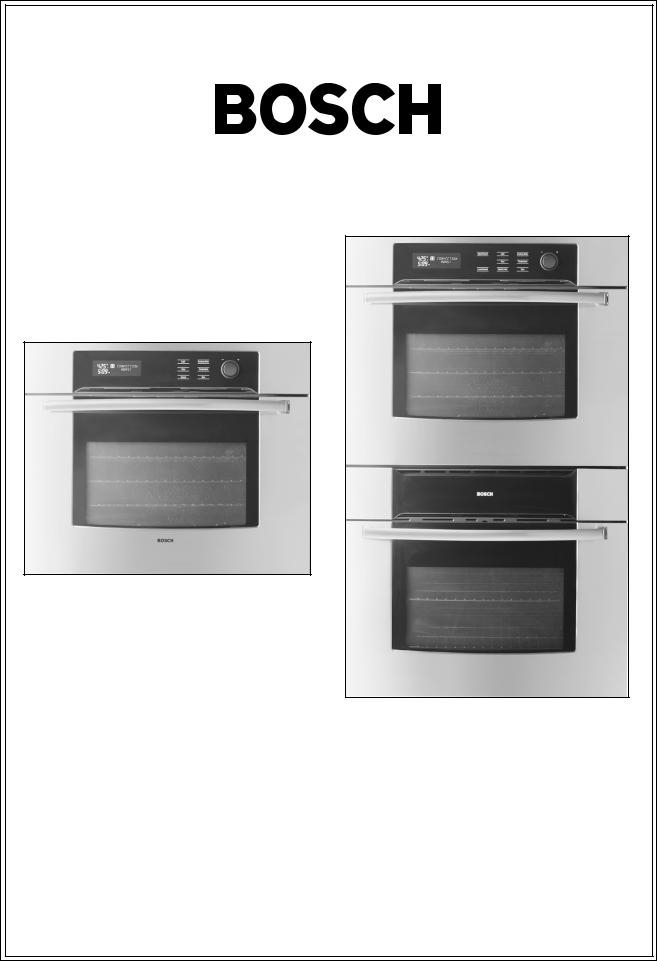
Use & Care Manual |
For |
Single and Double Built-in Ovens |
Models |
HBL 73../74../75../76.. and HBN 74../75../76.. |
© 2002 BSH Home Appliances Corp.

Bosch Oven Introduction
A Special Message
to Our Customers
Dear Bosch Oven Owner:
Thank you and congratulations on the purchase of your Bosch oven. Whether you are an expert chef or an aspiring cook, we know that your new oven will exceed your expectations. Decades of knowledge and experience are built into this oven making it among the highest quality, most versatile and most efficient available.
We ask that you read this manual thoroughly before using your new oven. Please pay particular attention to the Safety Precautions printed at the front of this book and the numerous safety hints and cautions placed throughout. Also,be sure to familiarize yourself with the proper operation of the oven and its cleaning and maintenance procedures. Adherence to these instructions and procedures will assure that you realize the full potential of your new Bosch oven as well as maintain it for years of dependable use.
Thank you and good cooking,
BSH Home Appliances

Table of Contents
Table of Contents
Safety Precautions ........................... |
2-3 |
Les Instructions De Sécurité ................. |
4-5 |
Important (Safety Instructions in French) |
|
Cooking with the |
|
BOSCH Convection Oven .................. |
6 |
Features ofYour Oven ........................ |
7-10 |
The Control Panel ....................................... |
8 |
Oven Modes .................................................. |
9 |
General Oven Information ...................... |
10 |
Oven Operation ........................... |
11-26 |
General Oven Tips ..................................... |
11 |
Setting the Clock........................................ |
12 |
Using Oven Timer ...................................... |
13 |
Using Oven Lights ...................................... |
13 |
Selecting the Oven Mode ......................... |
14 |
Time Oven Mode Operation .................. |
15 |
Bake Tips and Techniques ......................... |
16 |
Bake Cook Chart ....................................... |
17 |
Convection Bake Tips and Techniques .. 18 |
|
Convection Bake Chart ............................ |
19 |
Convection Roast Tips and Techniques . 20 |
|
Convection Roasting with the Probe 20-22 |
|
Convection Roast Chart .......................... |
23 |
Broil Tips and Techniques ......................... |
24 |
Broil Chart ................................................... |
24 |
Convection Broil ........................................ |
25 |
Convection Broil Chart ............................ |
25 |
Dehydrate Tips and Techniques ............... |
26 |
Warming Tips and Techniques ............. |
26 |
Proofing and Defrosting |
|
Tips and Techniques ................................... |
26 |
Special Features ........................... |
27-30 |
Lock Keys (Child Lockout) ...................... |
27 |
Sabbath Mode |
|
(for religious faiths with “no work” |
|
requirements on the Sabbath) ................ |
28 |
Oven Offset |
|
(calibrate the oven temperature) ........... |
28 |
Language (select English, |
|
Spanish, or French) .................................... |
29 |
Temperature Units |
|
(Fahrenheit or Centigrade) ...................... |
29 |
Clock Format (12 hr or 24 hr) ............... |
29 |
Beep Volume ................................................ |
30 |
View Clock .................................................. |
30 |
Default Data ................................................ |
30 |
Oven Care and Cleaning ............. |
31-34 |
Self-Cleaning the Oven ............................. |
31 |
Preparing the Oven for Self-Clean ......... |
31 |
Setting the Self-Clean Mode .................... |
32 |
General Oven Care ................................... |
33 |
Oven Finishes/Cleaning Methods ........... |
34 |
Do-It-Yourself Maintenance ........ |
35-40 |
Oven Door Removal ........................... |
35-36 |
Replacing an Oven Light ........................... |
37 |
Solving Problems ....................... |
38 - 39 |
Solving Baking Problems ........................... |
38 |
Solving Operational Problems ................. |
39 |
How to Obtain Service ...................... |
39 |
Model Warranty ................................ |
40 |
Service Data Record .......................... |
40 |
Page 1

Safety Precautions |
Bosch HBL7/HBN7 Oven Use and Care Manual |
General Appliance and Oven
SAFETY PRECAUTIONS
Please read all instructions before using this appliance.
▲! WARNING
When properly cared for, your new Bosch oven has been designed to be a safe, reliable appliance. Read all instructions carefully before using this oven. These precautions will reduce the risk of burns, electric shock, fire, and injury to persons. When using kitchen appliances, basic safety precautions must be followed, including the following:
•This appliance must be properly installed and grounded by a qualified technician. Connect only to properly grounded outlet. See “Grounding Instructions” found in the Installation Instructions.
•This appliance should be serviced only by a qualified service technician. Contact the nearest authorized service center for examination, repair or adjustment.
•Do not repair or replace any part of the oven unless specifically recommended. Refer service to an authorized servicer.
•Do not operate this appliance if it is not working properly or if it has been damaged, until an authorized servicer has examined it.
•Install or locate this appliance only in accordance with the Installation Instructions.
•Use this oven only as intended by the manufacturer. If you have any questions, contact the manufacturer.
•Do not cover or block any openings on this appliance.
•Use this appliance only for its intended use as described in this manual. Do not use corrosive chemicals, vapors, or nonfood products in this appliance. This type of oven is specifically designed to heat or cook. It is not designed for industrial or laboratory use. The use of corrosive chemicals in heating or cleaning will damage the appliance.
•In the event that personal clothing or hair catches fire, DROP AND ROLL IMMEDIATELY to extinguish flames.
•Do not allow children to use this appliance unless closely supervised by an adult. Children and pets should not be left alone or unattended in the area where the appliance is in use. Never allow children to sit or stand on any part of the oven.
•Do not store items of interest to children above the oven. If children should climb onto the appliance to reach these items, they could be seriously injured.
To reduce the risk of fire in the oven cavity:
1.Do not store flammable materials in or near the oven.
2.Do not use water on a grease fire. Smother fire or use a dry chemical or foam-type extinguisher.
3.It is highly recommended that a fire extinguisher be readily available and highly visible next to any cooking appliance.
4.Do not overcook food. Carefully attend oven if paper, plastic or other combustible materials are placed inside the oven.
5.Do not use the cavity for storage purposes. Do not leave paper products, cooking utensils or food in the cavity when not being used.
6.If materials inside the oven should ignite, keep oven door closed. Turn oven off and disconnect the circuit at the circuit breaker box.
7.Do not block any vent openings.
8.Be sure the blower fan runs whenever the oven is in operation. If the fan does not operate, do not use the oven. Call an authorized service center.
9.Never use the oven to warm or heat a room. This can damage the oven parts.
10.For personal safety, wear proper clothing. Loose fitting or garments with hanging sleeves should never be worn while using this appliance.
Continued on next page
Page 2

Safety Precautions |
Bosch HBL7/HBN7 Oven Use and Care Manual |
IMPORTANT SAFETY INSTRUCTIONS
Please read all instructions before using this appliance.
SAFETY FOR THE OVEN
•Tie long hair so that it doesn't hang loose.
•Do not touch heating elements or interior surfaces of oven.
•The heating elements may be hot even though they are dark in color. Interior surfaces of an oven become hot enough to cause burns.
•During and after use, do not touch or let clothing or other flammable materials contact the heating elements or the interior surfaces of the oven until they have had sufficient time to cool.
•The trim on the top and sides of the oven door may become hot enough to cause burns.
•Use care when opening the door. Open the door slightly to let hot air or steam escape before removing or replacing food.
•Do not heat unopened food containers. Build-up of pressure may cause the container to burst and cause injury.
•Always place oven racks in desired location while oven is cool. If a rack must be moved while oven is hot, do not let pot holder contact the hot heating elements.
•Use only dry pot holders. Moist or damp pot holders on hot surfaces may result in burns from steam. Do not let pot holder touch hot heating elements. Do not use a towel or other bulky cloth.
SAFETY FOR THE SELF-CLEANING OVEN
•Confirm that the door locks and will not open once START is touched and the door lock icon appears. If the door does not lock, touch UPPER CANCEL or LOWER CANCEL and do not run Self-Clean. Phone 800/735-4328 for service (see Page 39 for obtaining service).
•Do not clean the door gasket. It is essential for a good seal. Care should be taken not to rub, damage, move or remove the door gasket.
•Do not use commercial oven cleaners or oven liner protective coatings of any kind in or around any part of the oven.
•Clean only oven parts listed in this manual.
•Before self-cleaning the oven, remove the broiler pan, oven racks, other utensils and excess soft spillage.
▲! WARNING
The California Safe Drinking Water and Toxic Enforcement Act requires businesses to warn customers of potential exposure to substances which are known by the State of California to cause cancer or reproductive harm.
The elimination of soil during self-cleaning generates some by-products which are on this list of substances.
To minimize exposure to these substances, always operate this oven according to the instructions in this manual and provide good ventilation to the room during and immediately after self-cleaning the oven.
Page 3
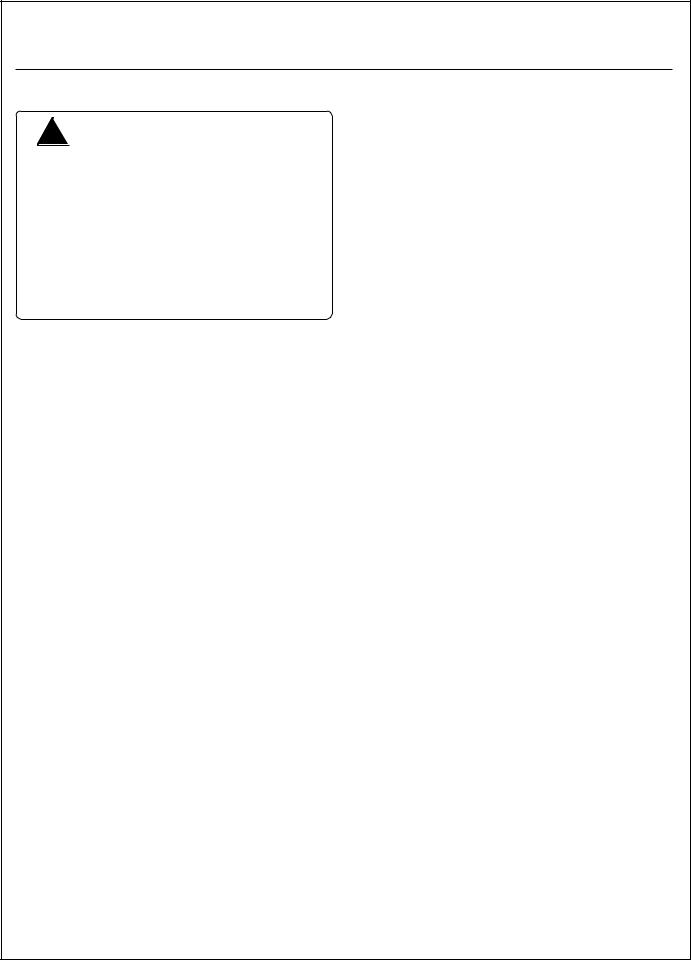
Safety Instructions |
Bosch HBL7/HBN7 Oven Use and Care Manual |
INSTRUCTIONS DE SÉCURITÉ
pour four et appareil en général
Lire toutes les instructions avant d’utiliser cet appareil.
! AVERTISSEMENT
AVERTISSEMENT
Lorsque l’entretien est effectué de façon appropriée, ce nouveau four Bosch a été conçu pour offrir sécurité et fiabilité. Lire attentivement toutes les instructions avant d’utiliser ce four. Ces précautions permettront de réduire tout risque de brûlures, de chocs électriques, d’incendie et de blessures. Au moment d’utiliser des électroménagers, des précautions de base doivent être observées, incluant ce qui suit.
•Cet appareil doit être installé et mis à la terre de façon appropriée par un technicien qualifié. Brancher seulement sur une prise mise à la terre. Voir « Instructions de mise à la terre » dans les instructions d’installation.
•Seul un technicien qualifié peut effectuer le service de cet appareil. Communiquer avec un centre de service autorisé pour toute vérification,réparation ou réglage.
•Dans le cas où des vêtements ou des cheveux prennent feu, SE LAISSER TOMBER AU SOL ET SE ROULER IMMÉDIATEMENT pour éteindre les flammes.
•Ne pas laisser des enfant utiliser cet appareil, à moins d’une surveillance étroite d’un adulte. Les enfants ou des animaux ne doivent pas être laissés seuls ou sans surveillance lorsque cet appareil est utilisé. Ne jamais laisser les enfants s’asseoir ou monter sur l’appareil.
•Ne jamais ranger d’articles, pouvant intéresser les enfants, au-dessus du four. Si les enfants doivent monter sur le four pour atteindre ces objets, ils peuvent se blesser sérieusement.
Pour réduire les risques d’incendie dans la cavité du four :
1.Ne pas ranger de matériaux inflammables près ou dans le four.
2.Ne pas utiliser d’eau sur un feu de graisse.Étouffer le feu ou utiliser un extincteur de type à mousse ou chimique sec.
•Ne pas réparer ni remplacer toute pièce du four à moins que cela ne soit recommandé spécifiquement. Consulter un centre de service autorisé.
•Ne pas utiliser cet appareil s’il ne fonctionne pas adéquatement ou s’il a été endommagé sans qu’un technicien qualifié ne l’ait d’abord vérifié.
•Installer cet appareil seulement selon les instructions d’installation.
•Utiliser ce four pour l’usage auquel il est destiné par le fabricant. Pour toute question, communiquer avec le fabricant.
•Ne pas couvrir ni obstruer les ouvertures de cet appareil.
•Utiliser cet appareil seulement pour l’usage auquel il est destiné selon les instructions de ce guide. Ne pas utiliser de produits corrosifs, chimiques, ou des produits non alimentaires dans cet appareil.Ce type de four est conçu spécifiquement pour chauffer et cuire. Il n’est pas destiné à un usage industriel ou en laboratoire. L’utilisation de produits chimiques corrosifs pour le chauffage ou le nettoyage peut endommager l’appareil.
3.Il est recommandé qu’un extincteur soit disponible et placé visiblement près de l’appareil de cuisson.
4.Ne pas surcuire les aliments. Faire attention si du papier, du plastique ou autres matériaux combustibles sont placés dans le four.
5.Ne pas utiliser la cavité à des fins de rangement. Ne pas laisser de produits en papier, des ustensiles ou des aliments dans la cavité si l’appareil n’est pas utilisé.
6.Si des matériaux dans le four s’enflamment, laisser la porte du four fermée.Mettre le four hors circuit, débrancher le circuit à la boîte de jonction.
7.Ne pas obstruer les évents.
8.S’assurer que le ventilateur fonctionne lorsque le four est en marche. Si le ventilateur ne fonctionne pas, ne pas utiliser le four. Communiquer avec un centre de service autorisé.
9.Ne jamais utiliser ce four pour chauffer ou réchauffer une pièce. Ceci peut endommager les pièces du four.
10.Pour plus de sécurité, porter des vêtements adéquats. Des vêtements lâches ou pendants ne doivent jamais être portés si l’on utilise le four.
Suite à la page suivante
Page 4
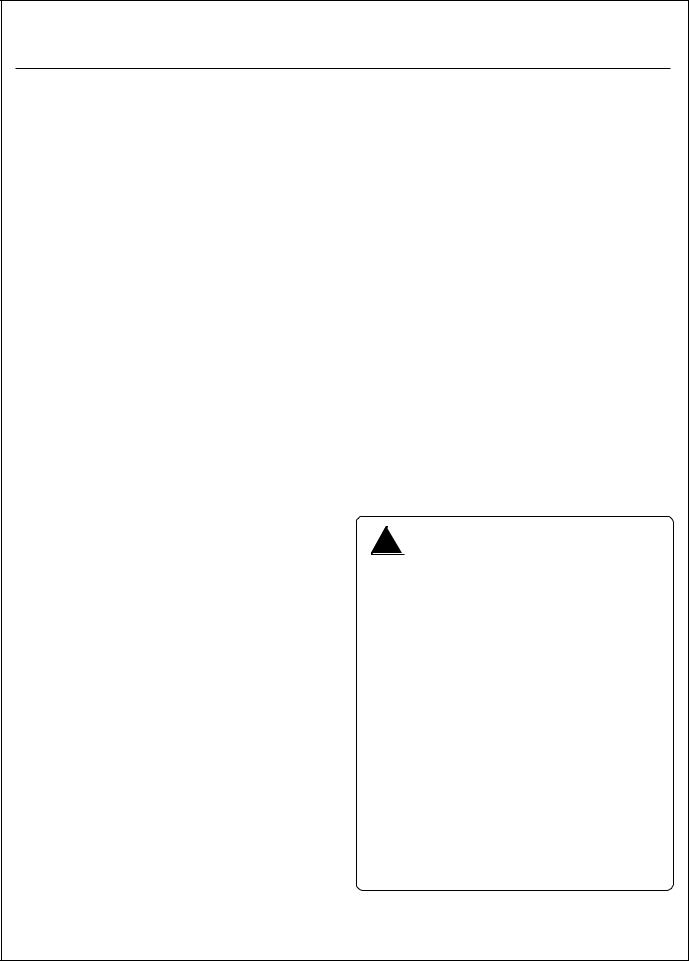
Safety Instructions |
Bosch HBL7/HBN7 Oven Use and Care Manual |
INSTRUCTIONS DE SÉCURITÉ IMPORTANTES
Lire toutes les instructions avant d’utiliser cet appareil.
SÉCURITÉ POUR LE FOUR
•Les cheveux longs doivent être attachés.
•Ne pas toucher aux éléments chauffants ni aux surfaces intérieures du four.
•Les éléments chauffants peuvent être chauds même s’ils sont de couleur foncée. Les surfaces intérieures du four sont suffisamment chaudes pour causer des brûlures.
•Pendant et après l’utilisation, ne pas toucher, ni laisser des vêtements ou autres matériaux inflammables entrer en contact avec les éléments chauffants ou les surfaces intérieures du four. Laisser suffisamment de temps au four pour refroidir.
•Les garnitures sur le dessus et les côtés de la porte du four peuvent devenir assez chaudes pour causer des brûlures.
•Faire attention en ouvrant la porte du four. Ouvrir la porte légèrement pour laisser l’air chaud ou la vapeur s’échapper avant d’enlever ou de mettre des aliments dans le four.
•Ne pas faire chauffer des contenants d’aliments hermétiques.L’accumulation de pression peut faire exploser le contenant et causer des blessures.
•Toujours placer les tablettes à l’endroit désiré lorsque le four est froid. Si une tablette doit être enlevée lorsque le four est chaud, ne pas laisser les tire-plats entrer en contact avec les éléments chauffants.
•Utiliser seulement des tire-plats secs.Des tire-plats humides ou mouillés sur des surfaces chaudes peuvent causer des brûlures de vapeur. Ne pas toucher aux éléments chauffants. Ne pas utiliser de serviettes ou autres chiffons.
SÉCURITÉ POUR LE FOUR AUTONETTOYANT
•S’assurer que la porte est verrouillée et ne peut s’ouvrir une fois la touche START pressée et que l’icone de porte verrouillée s’affiche. Si la porte ne se verrouille pas, presser la touche UPPER CANCEL ou LOWER CANCEL (annulation supérieure ou annulation inférieure) et ne pas actionner la fonction auto-nettoyante.Téléphoner au 800-735-4328 pour tout service (voir page 39 concernant le service).
•Ne pas nettoyer les joints de la porte. Cela est essentiel pour une bonne étanchéité. Il faut faire attention pour ne pas récurer, endommager, déplacer ou enlever le joint de la porte.
•Nettoyer seulement les pièces indiquées dans ce guide.
•Avant d’effectuer le nettoyage du four, enlever le plateau, les tablettes, les ustensiles et tout déversement.
! AVERTISSEMENT
AVERTISSEMENT
Le règlement « California Safe Drinking Water and Toxic Enforcement Act » exige que les compagnies avisent les clients du danger potentiel d’exposition aux substances reconnues par l’état de la Californie comme pouvant causer le cancer ou des problèmes de santé reliés à la reproduction.
L’élimination des résidus pendant le fonctionnement auto-nettoyant peut générer certains sous produits dérivés donnés dans la liste.
Afin de minimiser l’exposition à ces substances, toujours faire fonctionner ce four conformément aux instructions de ce guide et assurer une bonne ventilation à la pièce pendant et immédiatement après le nettoyage du four.
Page 5

Cooking with the Bosch Convection Oven |
Bosch HBL7/HBN7 Oven Use and Care Manual |
Cooking with the BOSCH Convection Oven
In a conventional oven, the heat source cycles on and off to maintain an average temperature in the oven cavity. As the temperature gradually rises and falls, gentle air currents are produced within the oven. This natural convection tends to be inefficient because the currents are irregular and slow. In the Bosch convection system, the heat is “conveyed” by a fan that provides continuous circulation of the hot air.
The Bosch Genuine European Convection™ system provides state-of-the-art engineering and advanced design to create the finest convection oven. In standard convection ovens, a fan simply circulates the hot air around the food.The Bosch convection system is characterized by the combination of an additional heating element located around the convection fan and the venting panel that distributes heated air in three dimensions: along the sides, the top and the full depth of the oven cavity. This Genuine European Convection system aids in maintaining a more even oven temperature throughout the oven cavity.
The circulating air aids in speeding up the baking process and cooks the food more evenly. By controlling the movement of heated air, convection cooking produces evenly browned foods that are crispy on the outside yet moist inside. Convection cooking works best for breads and pastries as well as meats and poultry.Air-leavened foods like angel food cakes, soufflés and cream puffs rise higher than in a conventional oven. Meats stay juicy and tender while the outside is flavorful and crisp.
By using Bosch Genuine European Convection, foods can be cooked at a lower temperature and cooking times can be shorter. When using the Convection Bake mode, the standard oven temperature should be lowered by 25°F. Foods requiring a cooking time of less than 30 minutes should be checked slightly earlier than normal. Items that typically cook for 45 minutes or more should take 15-25% less time. For best results, foods should be cooked uncovered, in low-sided pans to take advantage of the forced air circulation.When using the Convection Roast mode, the standard oven temperature does not need to be reduced.
Advantages of Convection Cooking
•Even baking, browning and crisping are achieved.
• During roasting, juices and flavors are sealed in while the exterior is crisp.
•Yeast breads are lighter, more evenly textured, more golden and crustier.
•Air-leavened foods such as cream puffs, soufflés and meringues are higher and lighter.
•Baking on multiple racks at the same time is possible with even results.
•Multiple-rack baking saves time.
•Prepare whole meals at once with no flavor transfer.
•Dehydrates herbs, fruits and vegetables.
•Requires no specialized bakeware.
•Saves time and energy.
•Convection broiling allows for extraordinary grilling with thicker cuts of food.
Page 6
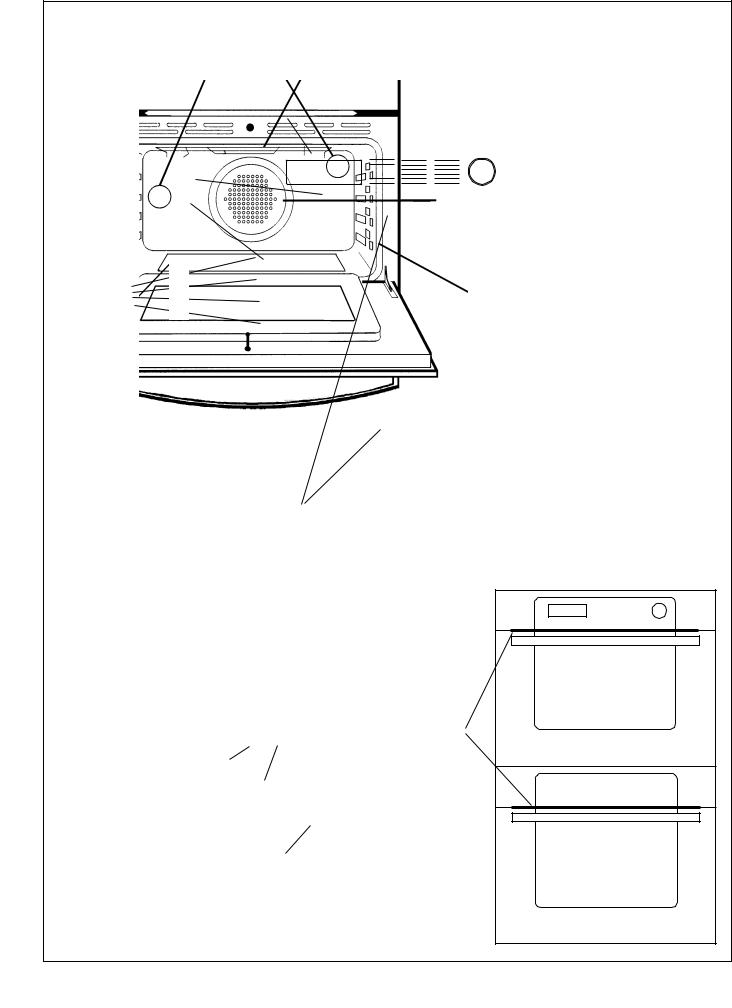
Oven Features |
|
|
|
|
Bosch HBL7/HBN7 Oven Use and Care Manual |
|
|
|
Features of Your Oven |
||||
|
|
Halogen Lights |
|
|
||
|
|
Control Panel |
|
|
Broil Element |
|
|
|
|
|
|
– |
+ |
|
|
|
Upper Cancel |
Light |
Cooking Mode |
|
Cooling Vents |
|
|
Time |
Temperature |
|
|
|
Lower Cancel |
Upper Lower |
Start |
|
||
|
|
|
|
|
||
Probe Receptacle |
|
|
|
|
|
|
|
(4) |
|
|
|
|
Convection Fan |
Rack Levels |
(3) |
|
|
|
|
and Element |
(2) |
|
|
|
|
||
|
|
|
|
(not visible) |
||
|
(1) |
|
|
|
|
|
Model & |
|
|
|
|
|
Door Gasket |
|
|
|
|
|
|
|
Serial # |
|
|
|
|
|
|
Plate |
|
|
|
|
|
|
Bake Element |
|
|
|
|
|
|
(not visible) |
Door Lock |
|
|
|
||
Oven Rack Back |
|
|
|
|
|
|
|
|
|
Probe |
|
|
|
Oven Rack Front |
|
|
|
|
|
|
|
|
Broiler Pan Racks |
Cooling Vents |
|
||
|
|
|
|
|
|
|
Page 7
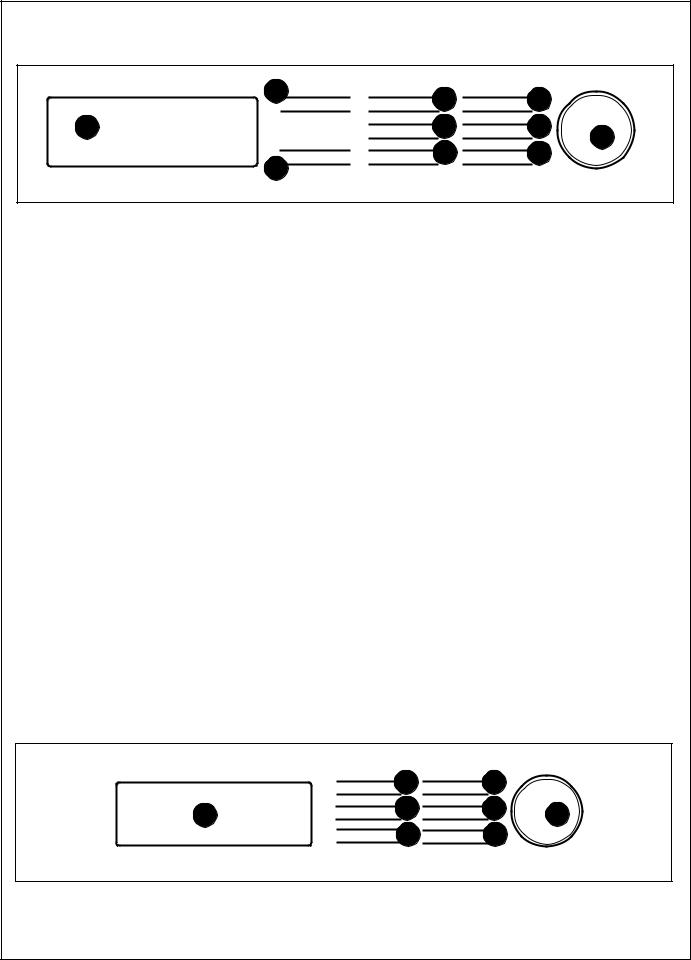
Oven Features |
Bosch HBL7/HBN7 Oven Use and Care Manual |
The Control Panel
2
Upper Cancel |
Light |
1 |
Time |
Lower Cancel |
Upper Lower |
2 |
|
3
4
5
Cooking Mode
Temperature
Start
–+
6
7
8
9
Double Oven Control Panel
The control panel allows you to program either the upper or lower oven. As you touch the pads and turn the control knob, words and numbers appear in the display window. Touch only one pad at a time.
1.Display Window – this window shows the following information:
•Clock – shows the time of day with a 12hour or 24-hour clock option (See Page 12).
•Timer Settings – counts down the time in minutes.
•Oven Selection – Upper and/or Lower.
•Cooking or Timed Mode – shows the number of hours and minutes the oven will be “on.”
•Elements – displays which element(s) are active during a cooking mode.
•Oven Temperature – Shows temperature setting in fahrenheit or centigrade. (See Page 29).
•PREHEAT – indicates that the oven is preheating.
2.UPPER CANCEL and LOWER CANCEL – touch to turn off active oven.
3.Light – touch to turn oven light on or off.
4.Time – touch to set the timer, change the timer or clear the timer.
5.Upper/Lower – touch to select the upper or lower oven. Oven selected is highlighted in the display window.
6.Cooking Mode – touch to display oven temperature, oven selected and cooking mode.
7.Temperature – touch to set cooking temperatures.
8.Control Knob – used to set the clock, timers, select cooking mode and temperature.Allows for increasing or decreasing numerals relating to clock time or timer setting and oven temperature. Push on knob to pop out the knob when making selections.Conversely, push the knob in to retract it back into the control panel after selections are made.
9.Start – touch to complete an entry.
Light
1 |
Time |
|
|
|
Cancel |
3
4
2
Cooking Mode
Temperature
Start
–+
6
7 8
9
Single Oven Control Panel
Page 8
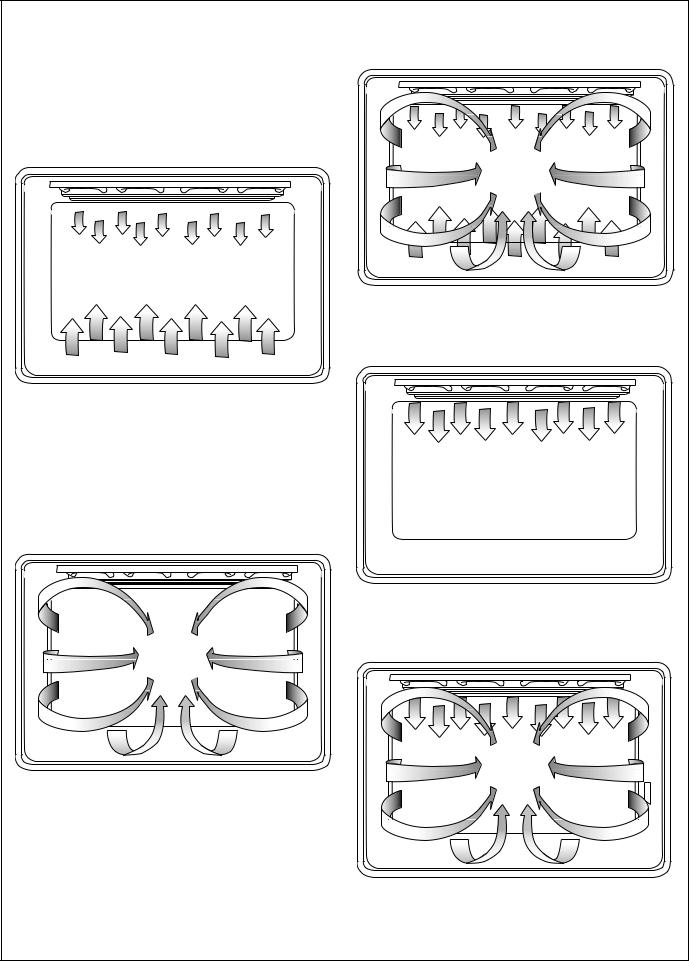
Oven Features |
Bosch HBL7/HBN7 Oven Use and Care Manual |
Oven Modes
The following illustrations give an overview of what happens in the oven with each mode setting. The arrows represent the location of the heat source during specific modes. The lower element is concealed under the oven floor.
BAKE and WARMING
Baking is cooking with heated air. Both the upper and lower element cycle to maintain the oven temperature. In the Warming mode, the oven will use the lower element to maintain a low temperature to keep food at serving temperature.
CONVECTION BAKE and DEHYDRATE
Convection Bake cooks with heat from a third element behind the back wall of the oven. The heat is circulated throughout the oven by the convection fan. Dehydrating is similar to convection cooking and holds an optimum low temperature while circulating the heated air to remove moisture slowly for food preservation.
CONVECTION ROAST
Convection Roast uses the top element, bottom element and convection fan.
BROIL
Broiling uses intense heat radiated from the upper element.
CONVECTION BROIL
Convection Broil combines the intense heat from the upper element with the heat circulated by the convection fan.
Page 9

Oven Features |
Bosch HBL7/HBN7 Oven Use and Care Manual |
General Oven Information
Before using your Bosch oven for the first time remove all packing and foreign materials from the oven(s). Any material of this sort left in the oven(s) may melt and/ or burn when the oven(s) is(are) used.
Flashing Symbols or Numbers
Signals an incomplete setting and calls for another step or START to be touched.
Beeps
Signals that more information must be entered or confirms the receipt of an entry. Beeps also signal the end of a function or an oven fault.
Probe Symbol 
The probe symbol will be displayed when the probe is inserted into the probe receptacle. The internal temperature of the meat is also displayed in place of the oven roasting temperature. The selected probe temperature can be displayed by touching TEMPERATURE. Oven temperature can be displayed by touching TEMPERATURE two times.
Lock Symbol 
Displays during the Self-Clean mode and when the door is locked. Do not attempt to open the door when the lock symbol or UNLOCKING DOOR is displayed. Door can be opened when the symbol no longer appears.
Power Failure
After the power returns to the oven, the clock displays the time when the power was lost or turned off.
Default Settings
The cooking modes automatically select a suitable temperature. These can be changed when a different one is needed.
F Number Codes
These codes are displayed when there is a problem with the signal sent to the electronic control board. See Solving Operational Problems, Page 39.
Convection Fan
The convection fan operates during any convection mode. When the oven is operating in the convection mode,the fan will turn off automatically when the door is opened. The convection fan will run during the preheat time for specific modes.
Component Cooling Fan
Activates during any cooking or self-cleaning mode to cool inner components and outer door surfaces. This air is exhausted through the vent located above the oven door. It continues to run until components have cooled sufficiently.
Page 10

Oven Operations |
Bosch HBL7/HBN7 Oven Use and Care Manual |
General OvenTips
Preheating the Oven
•Preheat the oven when using the Bake, Convection Bake and Convection Roast modes.
•Preheating for Convection Roast when using the probe is not recommended. See Pages 20 through 22 for details and tips.
•Selecting a higher temperature does not shorten the preheat time.
•Preheating is necessary for good results when baking cakes, cookies, pastry and breads.
•Preheating will help to sear roasts and seal in meat juices.
•Place oven racks in their proper position before preheating.
•During preheat, the selected cooking temperature can be displayed by touching TEMPERATURE.
•A beep will confirm that the oven is preheated and the selected cooking temperature will be displayed.
•Fast Preheat Bake and Fast Preheat Convection Bake can be used when time is crucial.
Operational Suggestions
•Use the cooking charts as a guide.
•Do not set pans on the opened oven door.
•Use the interior oven light to view the food through the oven door window rather than opening the door frequently.
Utensils
•Glass baking dishes absorb heat. Reduce oven temperature 25°F when baking in glass.
•Use pans that give the desired browning. The type of finish on the pan will help determine the amount of browning that will occur.
•Shiny, smooth metal or light nonstick/anodized pans reflect heat, resulting in lighter, more delicate browning. Cakes and cookies require this type of utensil.
•Dark, rough or dull pans will absorb heat resulting in a browner, crisper crust. Use this type for pies.
•For brown, crisp crusts, use dark nonstick/anodized or dark, dull metal utensils or glass bakeware. Insulated baking pans may increase the length of cooking time.
•Do not cook with the empty broiler pan in the oven, as this could change cooking performance. Store the broil pan outside of the oven.
High Altitude Baking
•When cooking at high altitude,recipes and cooking time will vary from the standard. For accurate information,write the Extension Service,Colorado State University, Fort Collins, Colorado 80521. There may be a charge for the bulletins.
Oven Condensation and Temperature
•It is normal for a certain amount of moisture to evaporate from the food during any cooking process. The amount depends on the moisture content of the food. The moisture may condense on any surface cooler than the inside of the oven, such as the control panel.
•Your new Bosch oven has an electronic temperature sensor that accurately maintains the temperature selected. Your previous oven may have had a mechanical thermostat that drifted gradually over time to a higher temperature. It is normal that you may need to adjust your favorite recipes when cooking in a new oven.
Oven Racks
•The oven has rack guides at four levels as shown in the illustration on Page 7.
•Rack positions are numbered from the bottom rack guide (#1) to the top (#4).
•Check cooking charts for best rack positions to use when cooking.
•Each level guide consists of paired supports formed in the walls on each side of the oven cavity.
•Always be sure to position the oven racks before turning on the oven. Make sure that the racks are level once they are in position.
•To remove oven rack from the oven, pull rack forward, lift rack up at front and then remove it.
•To replace an oven rack:
1.Place rear of rack between rack level guides.
2.While lifting front of rack, slide rack in all the way while lowering the front. Please refer to illustration on Page 7 if there is any question as to which side is the front of the rack.
•The racks are designed to stop when pulled forward to their limit.
•CAUTION! Never use aluminum foil to cover the oven racks or to line the oven. It can cause damage to the oven liner if heat is trapped under the foil.
120/240 vs. 120/208 Volt Connection
•Most oven installations will have a 120/240 voltage connection.
•If your oven is installed with 120/208 voltage, the preheat time may be slightly longer than with 120/ 240 voltage.
•The Self-Clean mode may also require a longer clean time, depending on the amount of soil.
Page 11
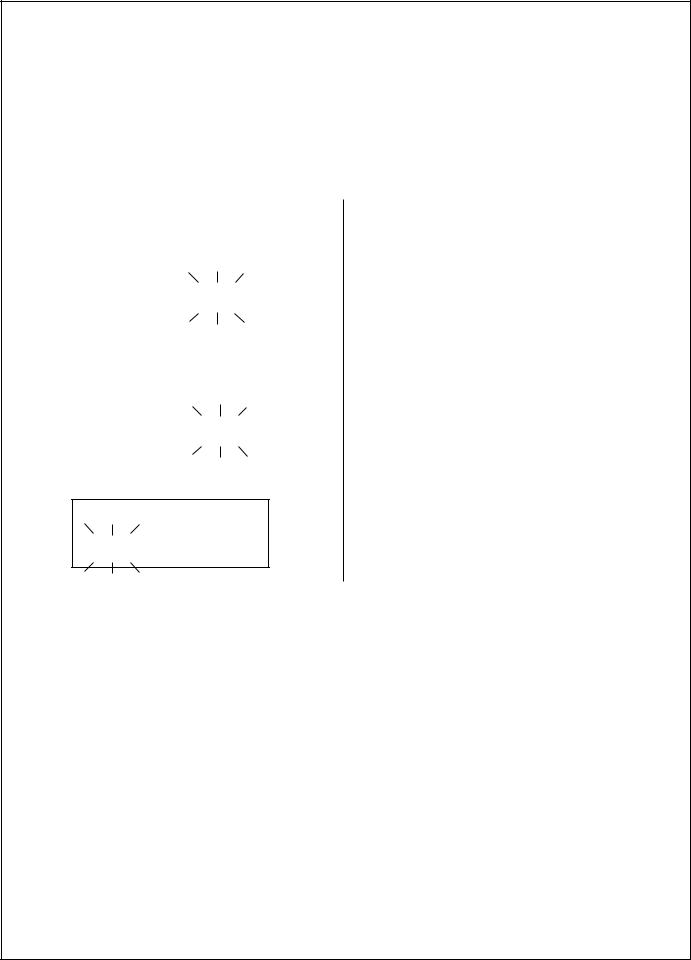
Oven Operations |
Bosch HBL7/HBN7 Oven Use and Care Manual |
Setting the Clock
•The time of day is displayed in hours and minutes.
•Always set the clock immediately after installation or after a power failure. Once power returns to the
oven, the clock displays the time of day when the power was turned off or lost.
•The clock time will appear during all oven operations except when the timer or a timed cooking operation is running.
•The oven is preset to a 12-hour clock and indicates AM and PM.
TO SET THE CLOCK:
1. Touch TIME. The display will begin flashing TIMER.
7:21 PM |
TIMER |
|
|
2.Turn rotary knob once to the right or left and CLOCK will flash in display.
7:21 PM |
CLOCK |
|
|
3.Touch TIME again. ENTER TIME will appear in the display and clock time will flash.
ENTER TIME
7:21 PM
4.Turn the knob to the right or left to quickly move the clock time forward or backward by 10-minute increments. Continue to rotate knob until correct AM or PM is selected.
5.After the initial move of the knob to either the right or left, turn the knob in the opposite direction to change the time by 1-minute increments.
6.Touch START. The clock is now set.
•If operation is not completed, the oven will beep periodically as a reminder to set clock time.Touch START.
•To cancel the CLOCK selection, touch CANCEL at any time when setting the clock.
Page 12
